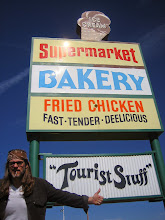The Miss LJH and I cooked Thanksgiving dinner this year for the Italians.
Chefs Extraordinaires
 Mlle. LJH
Mlle. LJH
Messr. ZDRM
More Pictures
All in all, the dinner was a clamorous success, due in equal part to the ingredients as it was to the braveur of the two chefs. Special credit is due to Miss LJH as she engineered the menù, hunted down the recipes, and took charge of most of the sides and desserts. I got to helm the turkey more or less, but I was merely following the instructions she tracked down.
The turkey was the finest ever. We followed closely the Cook’s Illustrated (Nov/Dec 1999) instructions, which included an overnight brining, then a hot-warm-hot baking method, starting the turkey face down then turning it on its back about 2/3 of the way through the cooking. The only innovation was the insertion of pancetta between the breast meat and the skin, something I have been accustomed to doing for the last many years, as it adds moisture, flavor and visual pizzazz to the breast meat.
I am not yet accustomed to the interest the Italians will show in the cooking process. In America, guests are content to peek under a pot or into the oven then repair to the salon (or, in my small abode, to the other end of the room) for hors d’oeuvres and martinis. And those appetizers –really no more than a distraction, a tactical move, so the guests will employ their pie holes elsewhere and not hassle the chef – work on the Americans. But here, my God, the curiosity is oppressive. Miss LJH and I were squeezed into a miniscule sliver of a kitchen, and as the guests arrived they one by one squeezed in there too, hanging over our shoulders to observe, sticking their fingers in sauces, and offering unsolicited advice on how to cook things. Anybody on close terms with any chef of self-regard will know that none of these behaviors is to be tolerated (friends call me the “kitchen fascist,” but in the kitchen, dictatorship is a good thing), however the latter, now that really chaps our hide. One guest went so far as to importune we let him check the temperature of the turkey with our meat thermometer, so he too could know, not only by our solemn word as chefs of high self-regard, but prima facie, that the temperature was proper and too his liking. Never mind that he didn’t know what the ideal temperature should be, nor did he know how to convert that to centigrade, nor had he even roasted a turkey in his life; he needed empirical evidence whence to expound his opinion. That guest quickly and tragically learned that one should not break chefs’ balls when there are cleavers at close hand, but what did LJH and I gain from that experience? As we mopped up we were left scratching our heads. Yes, we understood that the Italians have a near genetically bred interest in the nuts and bolts of assembling meals, but why in the name of God would they go this far? Don’t they know the old adage of too many cooks fucking up the hell out of the brodo?
The next morning, I was watching 1 Mattina, one of these home economy shows they have here on TV, which I have recently grown enamored of (an episode on the ins and outs of frozen fish has left me a changed man). There, in a cooking demonstration, I found my answer. Behind the burners stood three personages, the host, the chef, and the “maestro.” Ostensibly they were to demonstrate the preparation of tortiglioni with zucchine. Indeed, they did achieve their aims, but obliquely. I will recount this strange drama, that I am beginning to think epitomizes what Italians call “cucinare.”
In America how does one of these cooking demos go? Easy: the star chef announces the ingredients, throws them together in seconds (as they are already prepped and set into little clear bowls), stirs, beats, sears, tosses around a skillet (flying ingredients are rather telegenic), and finally presents the already-cooked dish from of a dutch oven/cooky sheet/poacher, to general applause and the thanks of the host. Cut to commercial. What could be more simple, direct and logical?
Here, the process verges on the baroque. Allow me to list the dramatis personae: first, the hostess of 1 Mattina, stage left of the stove; she is there pretty much for the cleavage and the occasional ejaculation of gasps when somebody mentions a food she especially fancies. At the mention of pasta carbonara, she nearly burst her dress, she was so transported by glee. True, I would get naked for pancetta too, but I still failed to understand why the host wasn’t off taking a smoke break at this point. Second, the so-called chef: a pleasant looking lady in her forties, in a dandy apron, turns out to be not the chef at all (in fact she actually confesses at the outset she doesn’t cook very well!), but rather a scapegoat for all that goes wrong in the cooking process. She is punished mercilessly. And finally, the mysterious figure hovering ominously –and at first pointlessly – stage right: he is the bearded and gravelly voiced “maestro,” who half way through the cooking process will save a potential culinary disaster transforming the dish into something entirely different.
The program commences quite normally; the ingredients are announced, the chef tosses the pasta in the water, and begins a sauté of the onions, adding the zucchini slices a little later. We are five whole minutes into this demo when the maestro begins to grumble, deeming the onions, already sizzling in the pan, far too coarsely chopped. The chef-aster begs to be excused from this error, explaining “they were chopped like this when I got here.” (This we viewers understand, she is forgiven. But somebody, some stagehand somewhere, should have chopped those better, right?) The maestro is implacable, he then inveighs against the thickness of the zucchini slices (they too already in the pan) explaining that the onions will be burnt before the zukes will be cooked. He pushes the chef aside and takes center stage. The chef, still protesting innocence and wringing her hands in her apron, stands back while the maestro demonstrates (with an excellent ceramic knife, I might add) how to produce paper-thin zucchini slices with a machine-gun rapidity that betrays his professional training. “Well,” exclaims the chef at this point, “we don’t have the training you have, you know.” Obviously this guy has sharpened his chops in many kitchens. He probably heads up a restaurant somewhere. As a foreigner I don’t recognize him, but he’s probably just as famous here as Mario Batali is stateside; that’s why they call him “maestro,” after all, to be sure. The show ends pitifully for the chef; she is left slicing chunks of scamorza stage left (with a pitiful 2 euro paring knife I might add) that will never be employed in the final recipe. And the maestro saves the dish with a dramatic flourish. He throws the entire congeries of vegetables in the pasta water, strains it, and dumps everything back into the skillet. He produces some heretofore-unseen herbs from under the counter and sprinkles them into the pan. He shakes and tosses his skillet, giving the ingredients some air time (the telegenic flying vegetable: probably the only thing their cooking programs have in common with ours). Then voilà, he plates it, sets in a sprig of basil, and stands back with his hands spread, like a star tenor, waiting to bow after a killer aria. The goes wild; even the chef is exultant.
If we take pop culture at face value we must accept this program as demonstrative of the Italian modus vivendi, and not the exception. An American may be at first stumped by the poorly prepped food, the chef’s ineptitude, and the three characters talking over each other, in turn accusing and exculpating. It seemed like total chaos. But it becomes clear that the program was deliberately engineered to function this way. The onions and zucchinis were prepared improperly, precisely so the maestro could show off his chopping flair. Likewise the whole cooking demo was constructed so that it would fall to pieces midway, to give a dramatic edge to the maestro’s salvation of the hapless plate of pasta in question. Indeed, a perfect dramatic trajectory is revealed, complete with a crisis (ill prepared chef, and vegetables), rising action (when maestro takes center stage), and a spectacular resolution of the action (the plating of the pasta). The boiling tortiglioni even added a great cliffhanger: would our heroes save this dish before the maccheroni were overcooked? (Overboiled pasta is anathema to Italians. Their word for it, “scotta,” is spat with the same horror they express mentioning terrorist attacks.)
In short, this show reveals to us the stereotype we already know: that Italians love a little theater in every aspect of life. While we American expatriates, with an intimate and longstanding familiarity with Italian culture seek beyond such commonplaces, we often find ourselves returning to them. But the return is not pitiful in any way. On the contrary, it is triumphant. Though the stereotype here, the Italian need for drama, is indeed confirmed, the important difference is in the transformed perspective of the witness, in this case me. Years of personal observation and experience have not left me untouched, and I have gradually learned over this time that drama is indeed the essential stuff that a life is made of. To create such action in everyday events is to affirm the beauty of you own existence; why watch television when life is already so crammed with thrills? It is true that there are moments when this is exaggerated: when the bus arrives late because the driver had a spat with his lover, or, to note a more nefarious example, in the quotidian workings of the Italian parliament; however, by and large this way of life is more than mere “theatricality” as we Anglo-Saxons might put it. It is, instead, a proud affirmation of the importance of individual existence. I do not mean to say that this is a country of individualists; indeed certain systems in Italy will work to obliterate this. While American efficiency often reduces one to a “cog in the machine”; Italian bureaucracy, in turn, makes one feel more like a deliberately misfiled document, unstamped unsigned and therefore invalid. But through drama, the Italian’s clamorous assertion of his part in this action, he recuperates his individual importance on the stage of life. And therefore in the “politics of everyday life” (to use Paul Ginsbourg’s term) we see that his drama is an act of protest, and a proud assertion of the human, which tenaciously roots itself in the wake of any phenomenon that seeks to upset or destroy it.


0 Comments:
Post a Comment
<< Home